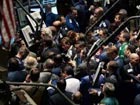| Videos | • Latest |
|
• Feature | • Sports | • Your Videos |
700-billion-dollar bailout: will it work?
![US President George W. Bush makes a statement in the Rose Garden of the White House in Washington, DC on October 3, 2008. Bush on Saturday praised legislators from both major parties for approving the 700 billion dollar financial system bailout package, but warned that relief would not be instant. [AFP] US President George W. Bush makes a statement in the Rose Garden of the White House in Washington, DC on October 3, 2008. Bush on Saturday praised legislators from both major parties for approving the 700 billion dollar financial system bailout package, but warned that relief would not be instant. [AFP]](http://images.china.cn/attachement/jpg/site1007/20081006/000cf1a487730a53ec3d15.jpg) |
|
US President George W. Bush makes a statement in the Rose Garden of the White House in Washington, DC on October 3, 2008. Bush on Saturday praised legislators from both major parties for approving the 700 billion dollar financial system bailout package, but warned that relief would not be instant. [AFP] |
![Traders on the floor of the New York Stock Exchange on September 26. Citigroup took over Wachovia bank in the latest forced marriage of the global financial crisis as Congress began debating a 700 billion-dollar bailout plan and European banks were shaken by the debt turmoil.[AFP] Traders on the floor of the New York Stock Exchange on September 26. Citigroup took over Wachovia bank in the latest forced marriage of the global financial crisis as Congress began debating a 700 billion-dollar bailout plan and European banks were shaken by the debt turmoil.[AFP]](http://images.china.cn/attachement/jpg/site1007/20081006/000cf1a487730a53eb9d14.jpg) |
|
Traders on the floor of the New York Stock Exchange on September 26. Citigroup took over Wachovia bank in the latest forced marriage of the global financial crisis as Congress began debating a 700 billion-dollar bailout plan and European banks were shaken by the debt turmoil.[AFP] |
Many hope the bailout plan will lend a calming effect to the market. The centerpiece of the bill allows the government to eventually buy up seven-hundred billion US dollar in assets tied to shaky mortgages. Getting the bad paper off banks' balance sheets could hopefully give institutions more confidence to start lending again.
Treasury Secretary Henry Paulson has up to forty-five days to devise a plan to purchase the assets.
But one big question is what the Treasury Department will pay for those assets. Experts say if the price is too low, banks may find they still need to take steps to shore up their balance sheets. Some may have to raise additional capital, which has been scarce in this tumultuous market. Investors may remain on the sidelines for a while until things shake out.
The plan's passage has also done little to allay fears in the stock market, which sold off once the House approved the bill. Investors, who remain skittish that the bailout plan will achieve its goals, sent the Dow Jones industrial average down 1.5 percent.
Experts say lending can not ramp up overnight and the bailout plan won't instantly eliminate all concerns. It may take weeks for confidence to return or even longer.

 0 Comments
0 Comments







Comments